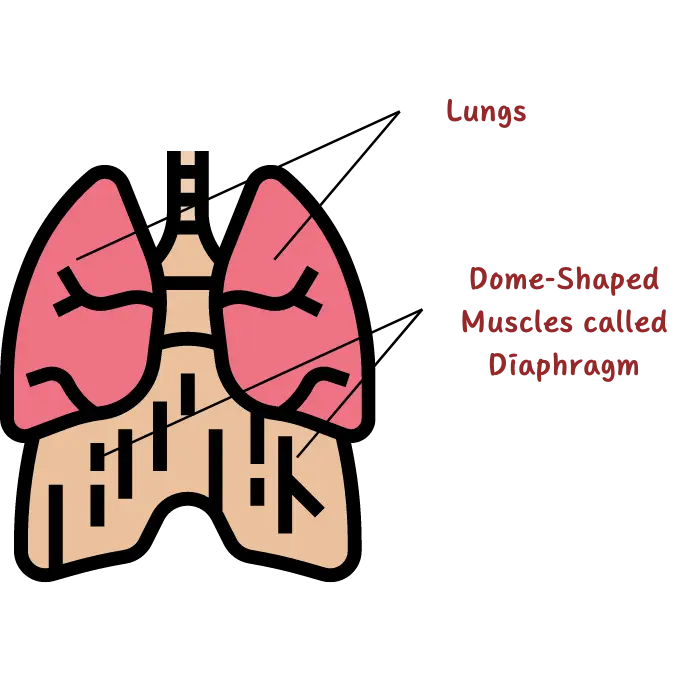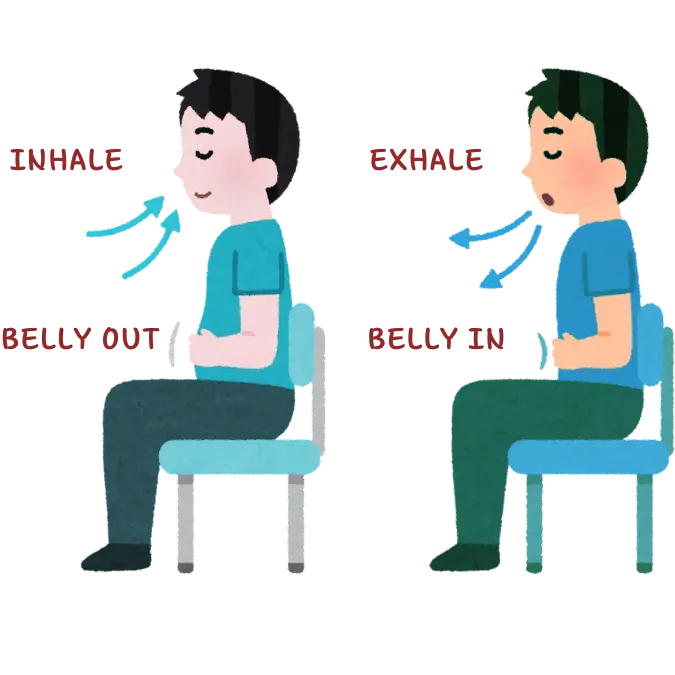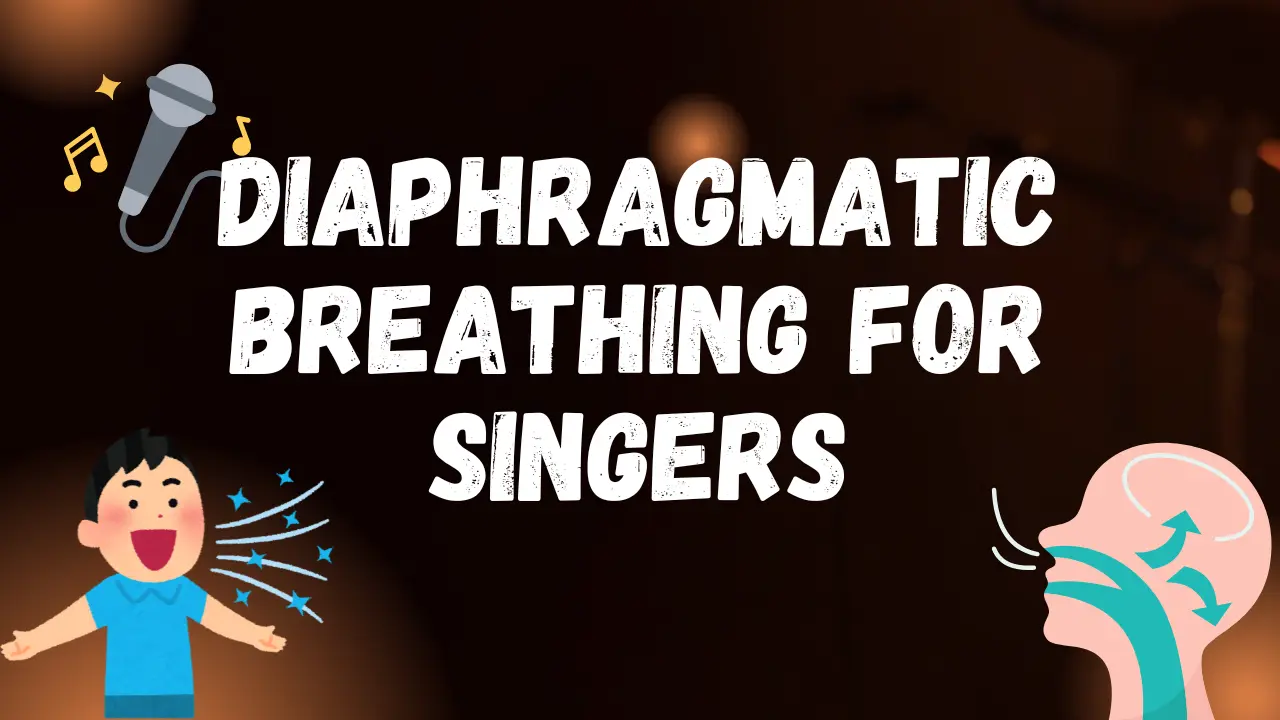- Anatomy of a Diaphragm
- Benefits of Diaphragmatic Breathing?
- Increased Breath Control
- Reduces Vocal Strain
- Helps in Producing Fuller Sound
- Richer Vocal Dynamics
- Wider Vocal Range
- Increases endurance
- How to Practice Diaphragmatic Breathing for Singers?
- Diaphragmatic Breathing Exercises for Singing
- Few tips for Diaphragmatic Breathing for Singers
- Diaphragmatic Breathing vs Chest Breathing
- Closing Thoughts!
- FAQs
What is Diaphragmatic Breathing for singers? I would start talking about this to my students right after they learn 7 basic pitches. This is a fundamental technique that most of the singers as well as learners learn in a very later stage and struggle to get acquitted to a different pattern of breathing.
While singing this technique can be achieved with a clear understanding along with practicing some Diaphragmatic breathing exercises. Let’s begin with the basics!

Did You Know?
Diaphragmatic breathing is sometimes referred to as belly breathing.
Anatomy of a Diaphragm

Diaphragm muscles look like a dome and are located just below your lungs. It lies between thoracic and abdominal cavities. When you breathe in and out, your lungs fill with air as they deflate and inflate.
When you breathe in, the diaphragm contracts creating negative pressure in the lungs. Now when you breathe out, the diaphragm relaxes and pushes the air out.
Benefits of Diaphragmatic Breathing?
For singers, the Diaphragmatic breathing technique is very essential because it optimises stamina, breath control and vocal health. Here are few of other benefits of diaphragmatic breathing.
Increased Breath Control
Steady airflow is one of the biggest advantages of Diaphragmatic Breathing for singing. Consistent flow of air is required for maintaining an even tone and volume. Sometimes we need to sing long phrases without running out of breath. Only following a diaphragmatic breathing techniques can help you bring out long phrases with controlled dynamics and max energy.
Reduces Vocal Strain
Our vocal cords strain a lot when we continuously sing or try to sing loud, whisper or while trying to hit the high notes. It’s quite unavoidable. But there is a silver lining here. Diaphragmatic breathing technique optimizes your lung capacity thereby creating sufficient breath support. You can also reduce the strain on your vocal cords to some level.
You should always remember that proper breath support reduces the risks of any injury of your vocal cords. And so diaphragmatic breathing techniques help you to maintain good vocal health.
Helps in Producing Fuller Sound
It’s a proven point that Diaphragmatic Breathing for singers bring out fuller and richer sound. It also enables singers to sing at their max volume without much straining of vocal cords. Controlled breath support brings out the vocal power. Over usage of muscles makes your throat tired.
Richer Vocal Dynamics
It is great tool to express various emotions while singing. A Diaphragmatic breathing for singers, allows you to maintain a smoother transitioning between the different Vocal dynamics.
Wider Vocal Range
Truth be told, teaching Diaphragmatic breathing exercises for singing to increase vocal range begins with understanding of the technique. It lets you direct your voice properly. Transitioning between vocal registers also becomes easy and smooth.
Increases endurance
Longer hours of practice or performance? No problem! Since Diaphragmatic Breathing controls vocal strain, longer durations of singing without vocal fatigue is absolutely possible. You don’t have to worry about the quality of your performance along with voice clarity.
To conclude the importance of diaphragmatic breathing for singers, every vocal technique revolves around with this. The quality of your singing improves vastly.
How to Practice Diaphragmatic Breathing for Singers?

When I say Diaphragmatic breathing technique, you must remember your belly moves in and out. So here’s how it works.
During this breathing technique you can clearly see your abdomen muscles along with your belly. When the diaphragm contracts (during inhalation), the abdomen muscles and your belly visibly expands or bulges out. This is because your diaphragm moves downwards towards your abdominal cavity, creating more space to store the sir. And when you exhale, the diaphragm relaxes and your belly folds in along with your abdomen muscles.
Diaphragmatic Breathing Exercises for Singing
Exercise – 1
- Lie down comfortably on a flat surface.
- Place one hand on your stomach and the other hand on your chest.
- Take a deep breath through your nose making sure that your stomach expands without moving your chest.
- Chest being still, exhale through your mouth. Let your stomach relax and bulge out.
- Keep counts and repeat this process until your chest stops moving
Exercise – 2
- Inhale for 4 counts through your nose silently.
- Try to hold your breath for 7 or 8 counts.
- Now exhale through your mouth for 8 7 or 8 counts with an “ssssss” sound
- Keep repeating until you feel relaxed without panting.
Exercise – 3
This one is quite tricky but very useful!
- Inhale through your nice for 5 seconds and make sure your abdomen expand
- Hold it for 5 seconds
- Exhale for 5 seconds and make sure your abdomen relaxes completely.
- Hold for 5 seconds.
- Keep doing this to get a sense of rhythm. Concentrate on your abdomen muscles rising and falling.
Few tips for Diaphragmatic Breathing for Singers
- I would ask my students to place a book on their head and stand against the wall, to make sure they maintain a good poster and to make sure that they don’t move their chest/shoulders while figuring out Diaphragmatic Breathing for singing.
- Before making sure your abdomen muscles are engaged, you can concentrate on moving your belly out and in while breathing in and out.
- Try to consciously engage the diaphragm while breathing for singing until it becomes a habit.
- Relaxing your body during each breath cycle is a necessary tool to achieve Diaphragmatic Breathing for singers.
- You should start with lesser counts while practicing the breathing exercises and work your way up.
- Just like learning any other musical concept, consistency is the key to improve your breath support and strengthen your diaphragm.
Diaphragmatic Breathing vs Chest Breathing
The diaphragm is a dome-shaped muscle present at the bottom of your lungs and is the main muscle used in diaphragmatic breathing. This is sometimes referred to as abdominal or deep breathing. When breathing diaphragmatically, the diaphragm contracts when you inhale, expanding the abdomen. And so more room is created in the chest cavity for the lungs to expand, enabling a deeper breath intake.

Did You Know?
Diaphragmatic breathing has effective oxygen exchange and with more oxygen enters your bloodstream with efficient carbon dioxide emission.
Meanwhile, chest breathing lets your shoulders and chest expand slightly leaving your diaphragm contracting less. The muscles in the neck, shoulders, and chest are used more often in chest breathing. It is said that stress or anxiety, or any conditions that require fast breathing are automatically linked to chest breathing. Which is why singers who use chest breathing often run out of breath soon and struggle to sing for a long time.
Closing Thoughts!
It is vital to remember that, Diaphragmatic Breathing technique is required to learn and nail almost every singing concept. It prompts more efficient delivery in singing without much tension. Book a Free Demo with us today to learn these concepts easily and efficiently!
FAQs
What is diaphragmatic breathing?
Diaphragmatic breathing is a technique that uses the diaphragm and the abdomen to breathe efficiently.
What are the benefits of diaphragmatic breathing?
It reduces vocal strain, produces fuller and richer sound, efficient and deep breathing.
How do I practice diaphragmatic breathing?
You can practice through the few exercises mentioned in the blog.
How is diaphragmatic breathing different from regular breathing?
Diaphragmatic breathing involves the diaphragm, abdomen and stomach while normal breathing involves the movement of the chest, shoulders etc.
Is diaphragmatic breathing belly breathing?
Yes. Diaphragmatic breathing is belly breathing.
How long should I practice diaphragmatic breathing each day?
You can start with a minimum of 5 mins a day.































